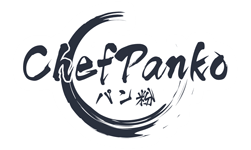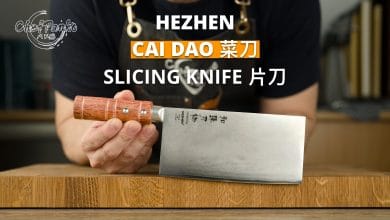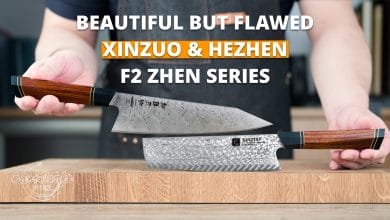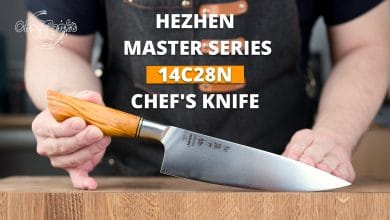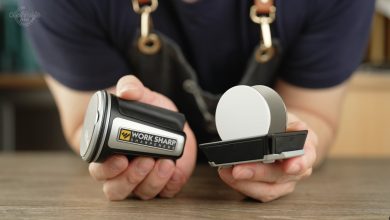The Xinzuo Feng Series Nakiri and Chef’s knife stands out with its unique design, particularly noticeable from the blade to the handle. It comes with 49 layers of Damascus patterns, the amount of layers does not add much other than aesthetics. It comes with an imported Japanese SRS13 core steel which is heat treated to a Rockwell of 62 to 64. It comes with great edge retention and corrosion resistance, The SRS13 core steel is comparable to SG2 steel.

Handle Design
The handle of the Xinzuo Feng Series is quite intriguing due to its unconventional design. It features a thick contoured front part that narrows significantly towards the end underneath the handle.

However, this design may not be suitable for individuals who have a large hand size, particularly if using a pinch grip on the blade. ‘

I found that my pinky finger could feel the edges of the narrow part, making it uncomfortable to hold for extended periods.

While the large front part felt adequate in my hands, it might be too thick for those with smaller hand sizes.

I found the handle most comfortable when held with my thumb on top or gripping the handle entirely, as the contours aligned nicely with my hands. Although I don’t recommend these gripping styles, I recognize that many home cooks use this type of grip.

Therefore, determining the handle’s comfort and suitability may require a hands-on evaluation. Considering accessibility limitations, if you have a medium to small hand size for males or a medium to large hand size for females, this knife may be worth considering.

The Blade & Blade Profile of the Feng Series Nakiri
The blade of the Xinzuo Feng Series Nakiri is quite intriguing due to its unique design. Its taller width serves as a knuckle guide, making it easy to use. Moreover, it’s longer than your typical Nakiri and features a flared-out tip, which comes in handy for tasks like slicing through onions. However, the blade profile isn’t entirely smooth. There’s a flat spot at the beginning followed by a small curve. While the flat spot facilitates an up-and-down motion, the curve that follows interrupts the motion slightly, resulting in a less smooth cutting experience beyond that point.

Additionally, if you prefer a rocking motion, the flat spot doesn’t make contact with the cutting board. The difference in the blade profile might be a production error, but I can only assess the product based on what I received. The blade is 55mm wide, giving you enough knuckle clearance no matter what gripping style you use. The added hammered pattern does help make food stick less to the blade.

The Blade & Blade Profile of the Feng Series Chef Knife
The blade profile on the chef’s knife is on the straighter side but the profile is nice and smooth with no abrupt stops. For the rest, it has the same width and knuckle clearance along with a hammered pattern just like the Nakiri. The profile is great for both the rocking and the up-and-down motion. The narrow front is great for precision cuts and you can cross your finger over so that food stays in its place. That is ideal for fanning out the cuts afterward.

Choil & Spine Taper
The choil of the Xinzuo Feng Series reveals a thinner profile behind the edge, transitioning to a thicker build towards the spine for both styles. This suggests that the knife is not optimized for precision cutting but rather suited for general kitchen tasks. The thicker choil contributes to a sturdier construction, enhancing durability and providing added heft to the knife. Across the entire spine, the thickness measures around 2.2mm meaning that there is no spine taper for both blade styles.

Balance Point & Weight
The point of balance is above the heel or around the neck area for both versions. If you pinch at that area the knife will neither be front nor back heavy. But with a weight of 243 grams on the Nakiri and 230 grams on the Chef’s knife, both knives are on the heavy side making it quite hefty which will help go through meat, but adds more weight for tasks that do not require that heft like vegetables.

Cutting performance, Blade grind & Blade Style
Given the thicker blade grind beyond the sharpened edge, you may experience slightly less smooth performance, especially when cutting through denser foods like carrots. However, despite this, the knife remains more than capable of handling tasks effectively. This blade grind is optimized for general use, meaning you won’t need to treat the knife as delicately as you would with a thinner ground blade. The wider overall blade from the heel towards the front provides a nice blade guide for your knuckles to slide through, enhancing blade and cutting stability. However, if you prefer to cross over your finger to keep food in place, this added front width may be a hindrance for the Nakiri-styled knife therefore the Chef’s knife version is more suitable for that task. In terms of cutting performance, both styles excel in general usage cutting tasks, but I wouldn’t recommend it for heavy-duty bone chopping.

Key Takeaways
The Xinzuo Feng Series Nakiri and Chef’s knife offers a unique design with its Damascus patterns and SRS13 core steel, providing great edge retention and corrosion resistance.

The flared-out tip and wider blade width make this Nakiri blade a fun-to-use knife and I hope to see more with this blade design.

However, its unconventional handle design may not be suitable for individuals with large hand sizes.

Despite minor blade profile issues on the Nakiri version, the knife performs well for general kitchen tasks. The Feng Series Chef’s knife has no profile flaws and performs smoothly it shares the same pros and cons of the Nakiri version. The narrow front is ideal for precision cutting, overall the Chef’s knife blade is good and I hope to see more series sharing the same blade shape. However, I do wish that there was a spine taper on the Chef’s knife version.

🛒SHOP:
Xinzuo Feng Series Nakiri Knife SRS13
Xinzuo Feng Series Chef’s Knife SRS13
Xinzuo Official Amazon Store
(SRS13 Feng Series not sold on Amazon yet)
The BamBoo Guy Official Xinzuo Reseller NA:
Xinzuo Feng Series Set SRS13
▶ If you want to know what knife you should buy you can read the following article ''Choosing your knife''. ▶ On my youtube channel, I have reviewed a lot of different knives. You can watch the playlist by clicking here. ▶ Click here, if you want to search for other kitchen knives on: Amazon. ▶ , if you want to search for other Chinese knives on . ▶ Check out my gear on Kit: https://kit.co/ChefPanko ▶ Check out my recommendation on Amazon: https://www.amazon.com/shop/chefpanko Full Disclosure: If you purchase from these links I get a small commission that goes towards supporting the channel and website. As an Amazon Associate, I earn from qualifying purchases ▶ If you have any questions about Japanese knives made in China or about some of the brands feel free to ask it in the comment section below. Thank you for your support and feedback. ▶ Want to work with me? Please use the contact form by clicking here.
